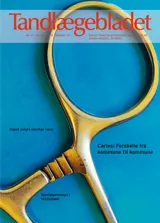Faglig viden om caries: Kan den kommunale tandpleje gøre det endnu bedre?
På trods af at den kommunale tandpleje i Danmark kan fremvise flotte resultater mht. cariesreduktion gennem tiderne, er der stadig en stor og uforklarlig variation i def-s- og DMF-S-værdierne kommunerne imellem. I 2004 havde 13% af de 15-årige et DMF-S = 0 i én kommune, mens hele 79% havde et DMF-S = 0 i en anden kommune. Formålet med denne artikel er at give inspiration til en professionalisering af cariesfaglige strategier så endnu bedre behandlingsresultater kan opnås i de nye storkommunale tandplejer. Vha. litteraturen kortlægger og beskriver artiklen 1) hvilke tænder og flader på børn og unge som hyppigst udvikler caries, 2) hvad vi ved om cariessygdommen i dag, 3) hvordan caries bør diagnosticeres, og 4) hvilke enkeltbehandlinger og programmer der virker reducerende på cariesforekomsten. Konsekvenserne af dette udmøntes så i forslag til en cariesstrategi med besøg, undersøgelser og udvidede undersøgelser, alle relateret til dentalaldre, samt forslag til risikorelaterede og symptomatiske cariesbehandlinger. Nøgleordet i fremtidens cariesbehandling er dentalaldre.
Knowledge about caries: Is it possible for The Danish Public Dental: Health Service for Children to achieve even better results? The Danish Public Dental Health Service for Children has obtained remarkable results durning the last 30 years concerning reducing the prevalence of caries among children and adolescents. In 2005 the mean DMF-S-scores among 15-year-olds was 2.68, and 47% had a DMF-S = 0. In spite of this there is still a huge, unexplained and unfortunate intermunicipality variation in caries experience among children and adolescents across Denmark. Thus, in 2004 in one municipality only 13% of the 15-year-olds had a DMF- S = 0, while 79% in another municipality had a DMF-S = 0. In order to obtain even better results in the new, big- scale municipalities, which will be established in 2007, the aim of this paper was to provide inspiration to the dental staff about how to optimize their strategy in managing caries. By means of the literature this paper describes 1) which teeth that most frequently develop caries in children and adolescents in Denmark, 2) what we do know about the ca ries disease today, 3) how to diagnose caries and 4) which single methods and programmes show a caries-reducing effect. This results in suggestions of how to manage caries including when the child/parents have to come to the clinic for the first time, when to perform examinations and extended examinations, the latter including bitewing radiographs. In addition suggestions are discussed about risk and caries-related treatments. The key word for managing caries in the future is dental ages.


